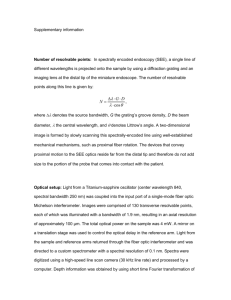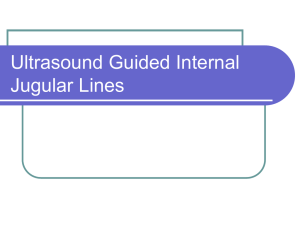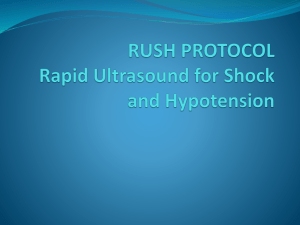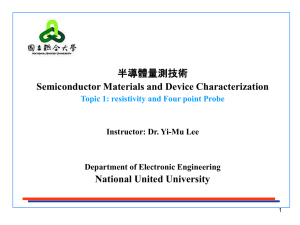Supplementary tables and figures:
advertisement
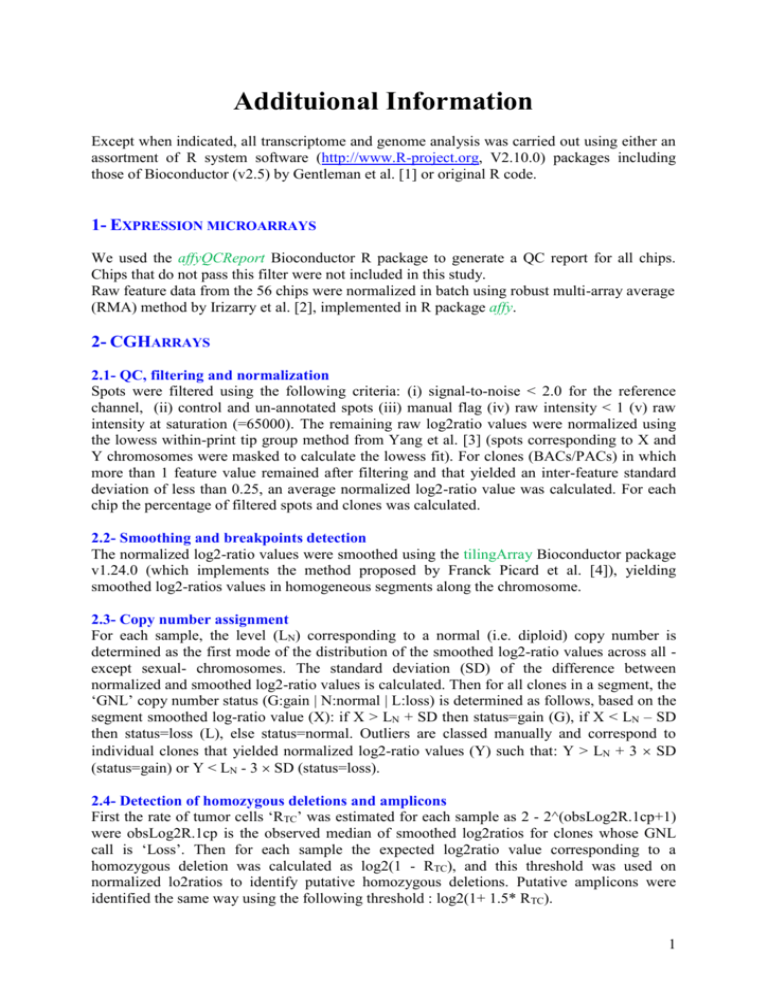
Addituional Information
Except when indicated, all transcriptome and genome analysis was carried out using either an
assortment of R system software (http://www.R-project.org, V2.10.0) packages including
those of Bioconductor (v2.5) by Gentleman et al. [1] or original R code.
1- EXPRESSION MICROARRAYS
We used the affyQCReport Bioconductor R package to generate a QC report for all chips.
Chips that do not pass this filter were not included in this study.
Raw feature data from the 56 chips were normalized in batch using robust multi-array average
(RMA) method by Irizarry et al. [2], implemented in R package affy.
2- CGHARRAYS
2.1- QC, filtering and normalization
Spots were filtered using the following criteria: (i) signal-to-noise < 2.0 for the reference
channel, (ii) control and un-annotated spots (iii) manual flag (iv) raw intensity < 1 (v) raw
intensity at saturation (=65000). The remaining raw log2ratio values were normalized using
the lowess within-print tip group method from Yang et al. [3] (spots corresponding to X and
Y chromosomes were masked to calculate the lowess fit). For clones (BACs/PACs) in which
more than 1 feature value remained after filtering and that yielded an inter-feature standard
deviation of less than 0.25, an average normalized log2-ratio value was calculated. For each
chip the percentage of filtered spots and clones was calculated.
2.2- Smoothing and breakpoints detection
The normalized log2-ratio values were smoothed using the tilingArray Bioconductor package
v1.24.0 (which implements the method proposed by Franck Picard et al. [4]), yielding
smoothed log2-ratios values in homogeneous segments along the chromosome.
2.3- Copy number assignment
For each sample, the level (LN) corresponding to a normal (i.e. diploid) copy number is
determined as the first mode of the distribution of the smoothed log2-ratio values across all except sexual- chromosomes. The standard deviation (SD) of the difference between
normalized and smoothed log2-ratio values is calculated. Then for all clones in a segment, the
‘GNL’ copy number status (G:gain | N:normal | L:loss) is determined as follows, based on the
segment smoothed log-ratio value (X): if X > LN + SD then status=gain (G), if X < LN – SD
then status=loss (L), else status=normal. Outliers are classed manually and correspond to
individual clones that yielded normalized log2-ratio values (Y) such that: Y > LN + 3 SD
(status=gain) or Y < LN - 3 SD (status=loss).
2.4- Detection of homozygous deletions and amplicons
First the rate of tumor cells ‘RTC’ was estimated for each sample as 2 - 2^(obsLog2R.1cp+1)
were obsLog2R.1cp is the observed median of smoothed log2ratios for clones whose GNL
call is ‘Loss’. Then for each sample the expected log2ratio value corresponding to a
homozygous deletion was calculated as log2(1 - RTC), and this threshold was used on
normalized lo2ratios to identify putative homozygous deletions. Putative amplicons were
identified the same way using the following threshold : log2(1+ 1.5* RTC).
1
2.5- Recurrent minimal genomic alterations
Computation of recurrent minimal genomic alterations was done in a similar way to the
method described by Rouveirol et al [5] using original R code.
3- UNSUPERVISED CLASSIFICATION OF SAMPLE EXPRESSION PROFILES
3.1- Unsupervised probe sets selection
Probe set’s unsupervised selection was based on the two following criteria:
a p-value of a variance test (see 3.2) less than 0.01,
a “robust” coefficient of variation (rCV, see 3.3) less than 10 and superior to a given
rCV percentile.
Eight rCV percentile thresholds were used (60%; 70%; 80%; 90%; 95%; 97.5%; 99%; 99.5%)
yielding 8 lists of probe sets.
3.2- Variance test
For each probe set (P) we tested whether its variance across samples was different from the
median of the variances of all the probe sets. The statistic used was ((n-1)Var(P) / Varmed),
where n refers to the number of samples. This statistic was compared to a percentile of the
Chi-square distribution with (n-1) degrees of freedom and yielded a p-value for each probe
set. This criteria is the same used in the filtering tool of BRB ArrayTools software [6].
3.3- Robust coefficient of variation
For each probe set, the rCV is calculated as follows: having ordered the intensity values of the
n samples from min to max, we eliminate the minimum value and the maximum value and
calculate the coefficient of variation (CV) for the rest of the values.
3.4- Obtention of a series of 24 dendrograms
We performed hierarchical clustering of the samples, using samples profiles restricted to each
of the 8 probe sets lists obtained via unsupervised selection (as described above), for 3
different linkage methods (average, complete and Ward’s), using 1-Pearson correlation as a
distance metric (package cluster). This analysis produced 24 dendrograms.
3.5- Stability assessment
The intrinsic stability of each of the 24 dendograms was assessed by comparing each
dendogram to dendograms obtained after data “perturbation” or “resampling” (100 iterations
for each). This comparison yielded a mean ‘similarity score’ (see 3.6) across all iterations.
Here, perturbation refers to the addition of random gaussian noise (µ = 0, = 1.5 median
variance calculated from the data set) to the data matrix, and resampling refers to random
substitution of 5% of the samples by virtual sample’s profiles, generated by random crossing
of existing profiles.
The overall stability of the classification was assessed by calculating a mean similarity score,
using all pairs of dendrograms obtained with the 8 probe sets lists for a given clustering
method.
3.6- Similarity score
To compare two dendrograms, we compare the two partitions being obtained by cutting in k
clusters (k=2..8) these two dendrograms. We then will compare several pairs of partitions
2
(one per value of k). To compare a pair of partitions, we used a similarity measure
corresponding to the symmetric difference distance (Robinson and Foulds, 1981).
NB: A similarity matrix A can be obtained from distance a matrix B by posing Aij = X – Bij,
where for any pair (i,j), Bij ≤ X.
3.7- Calculus of a consensus dendrogram and a consensus partition
To identify the groups of samples that consistently clustered together in the 24 dendrograms
(that is robust consensus clusters obtained independently from a given clustering method
and/or threshold for unsupervised genes selection), we first calculated a consensus
dendrogram using an algorithm proposed by Diday [7] and similar to the approach used by
Monti et al. [8]. We proceeded as follows: each of the 24 dendrograms was cut in k clusters,
thus yielding 24 partitions for each value of k (k = 2..8). We then calculated the (N,N)
symmetrical matrix S of sample’s co-classification (N = number of samples), giving for each
pair of samples the number of times they were in the same cluster group in the 24 partitions
(from 0 to 24). S is a similarity matrix, and a corresponding distance matrix D is obtained by
posing D(i,j) = 24 – S(i,j) (NB: D(i,j) = maximal_similarity – S(i,j)). Finally to obtain the
consensus dendrogram we use the distance D and complete linkage hierarchical clustering
method. Then, cutting this consensus dendrogram in k clusters, we obtained a consensus
partition for each value of k (k = 2..8). The level k=3 was choose as it showed very stable
clusters.
3.8- Choice of a representative dendrogram
To choose a representative dendrogram of the series of 24 dendrograms, we compared each of
the 24 corresponding partitions in k=3 clusters to the previously obtained consensus partition
in 3 clusters, using the similarity score defined above. Among the dendrograms yielding the
highest scores of similarity, we kept the one obtained with the smallest list of genes.
4- SUPERVISED TESTS AND CONTROL FOR MULTIPLE-TESTING
4.1- Expression profiles
Based on the RMA log2 single-intensity expression data, we used Limma moderate T-tests
(Bioconductor package limma [10]) to identify genes differentially expressed. The p.adjust
function from stats R package was used to estimate the FDR using the Benjamini and
Hochberg (BH) method [9].
4.2- Genomic profiles
Based on the clone based GNL copy number status (-1/0/1), homozygous deletion status (0/1)
and amplicon status (0/1), as well as based on MCR alteration status (0/1), we used Fisher
exact tests (fisher.test function, stats R package) to identify clones / MCR with differential
status. The p.adjust function from stats R package was used to estimate the FDR using the
Benjamini and Hochberg (BH) method [9].
4.3- Estimation of the H1 proportion 4.4- Centroids
Given a series pv of p-values, the related H1 proportion was estimated (using the approach by
B. Storey) as (1 – mean{Ind(pv > 0.5)})/0.5, where Ind(x>0.5) = 1 if x>0.5 and 0 otherwise.
4.4- Centroids
3
The centroids classification rule was obtained as follows : we performed an Anova comparing
the 3 cluster groups (C1, C2, C3) and retained the probe sets yielding a p-value less than 10-7.
For each paired comparison (C1 vs C3, C1 vs C3 and C2 vs C3) we then selected the probe
sets corresponding to the 20 highest and 20 lowest geometric mean fold changes, thus
obtaining a signature of 62 distinct probe sets (after removing redundancies). Centroids of the
3 cluster groups were calculated as the geometric mean of the probe sets of this signature.
Each sample profile (restricted to this signature) was compared to the 3 previously obtained
centroids using (1 – Pearson-coefficient-of-correlation) as distance. Samples were attributed
to the group yielding the lowest sample to centroid distance.
5- EXPRESSION BASED GENE SET ANALYSES
5.1- Gene Sets
KEGG
and
Biocarta
pathways
were
respectively
obtained
from
ftp://ftp.genome.ad.jp/pub/kegg/pathways/hsa and http://www.biocarta.com. GO terms and
their relationships (parent/child) were downloaded from http://www.geneontology.org.
Molecular Signature Database gene sets and Stanford Microarray Database gene sets were
downloaded
from
http://www.broadinstitute.org/gsea/msigdb/downloads
and
http://smd.stanford.edu. We mapped the biological pathway related genes or GO term related
proteins to non redundant HUGO gene symbols. For a GO term, we obtained the list of nonredundant related proteins identifiers, either directly associated to the GO term, or to one of its
descendants, and mapped it to a non-redundant list of HUGO gene symbols. Mapping
between original identifiers and symbols were obtained using biomaRt R package.
5.2- Gene Set Analysis Method
We used the hypergeometric test to measure the association between a non redundant list of
differentially expressed genes and a biological pathway or a gene ontology term (GO term), as
in GOstats R package. For each comparison (responders vs non responders), 2 lists of
differentially expressed genes (limma T-test p<0.05) were analyzed: Lup defined as the top
500 most up-regulated probe sets mapped to non redundant symbols, Ldown defined as the top
500 most down-regulated probe sets mapped to non redundant symbols.
6- SURVIVAL ANALYSIS
Survival curves were calculated according to the Kaplan-Meier method (function Surv, R
package survival, V2.29) and differences between curves were assessed using the log-rank
test (function survdiff, R package survival).
7- GENOME / TRANSCRIPTOME CORRELATION
We mapped BAC clones and probe sets based on their genomic position. Then for a pair
(clone, probe set), subgroups of samples analyzed both for transcriptome and genome were
used to calculate a Pearson coefficient of correlation between the normalized log2 RMA
intensity values (corresponding to the probe set) and the normalized log2-ratio values
(corresponding to the clone).
REFERENCES
1. Gentleman RC, Carey VJ, Bates DM, et al. Bioconductor: open software development
for computational biology and bioinformatics. Genome Biol. 2004;5:R80.
4
2.
Irizarry RA, Hobbs B, Collin F, et al. Exploration, normalization, and summaries of
high density oligonucleotide array probe level data. Biostatistics. 2003;4:249-264.
3. Yang YH, Dudoit S, Luu P, et al. Normalization for cDNA microarray data: a robust
composite method addressing single and multiple slide systematic variation. Nucleic
Acids Res. 2002;30:e15.
4. Picard F., et al. A statistical approach for CGH microarray data analysis. Research
report No. 5139, Institut National de Recherche en Informatique et en Automatique
(INRIA), ISSN 0249-6399, march 2004.
5. Rouveirol C, Stransky N, Hupe P, et al. Computation of recurrent minimal genomic
alterations from array-CGH data. Bioinformatics. 2006;22:849-856.
6. Simon R. and Peng Lam A., BRB-ArrayTools software v3.1 User’s Manual
linus.nci.nih.gov/BRB-ArrayTools.html, 2003.
7. Diday E. 1972. New concepts and new methods in automatic classification, PhD
thesis, University Paris VI , France.
8. Monti S, Savage KJ, Kutok JL, Feuerhake F, Kurtin P, Mihm M, Wu B, Pasqualucci L,
Neuberg D, Aguiar RC and others. 2005. Molecular profiling of diffuse large B-cell
lymphoma identifies robust subtypes including one characterized by host
inflammatory response. Blood 105(5):1851-61.
9. Benjamini, Y. and Hochberg, Y. (1995). Controlling the false discovery rate: a
practical and powerful approach to multiple testing. J. Roy. Statist. Soc. Ser. B 57
289-300.
10. Smyth GK et al. Linear models and empirical bayes methods for assessing
differential expression in microarray experiments. Statistical applications in genetics
and molecular biology. 3(1). 2004.
5



